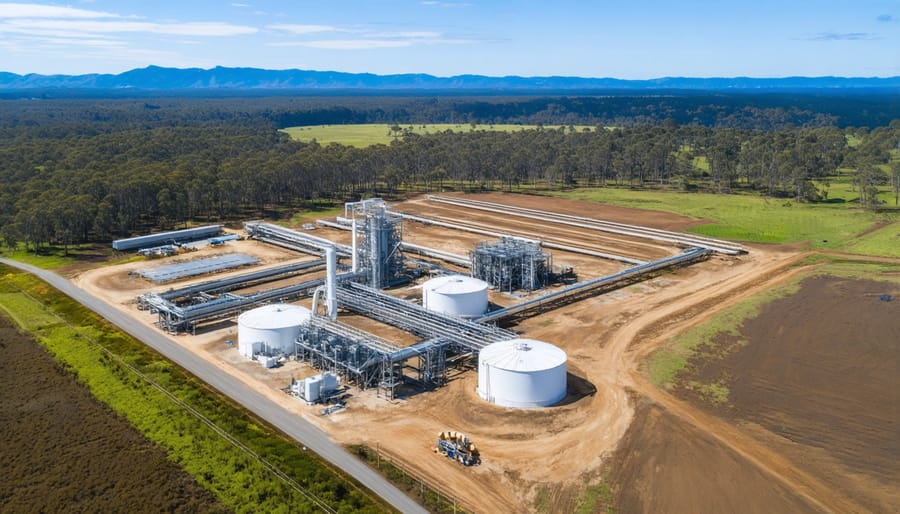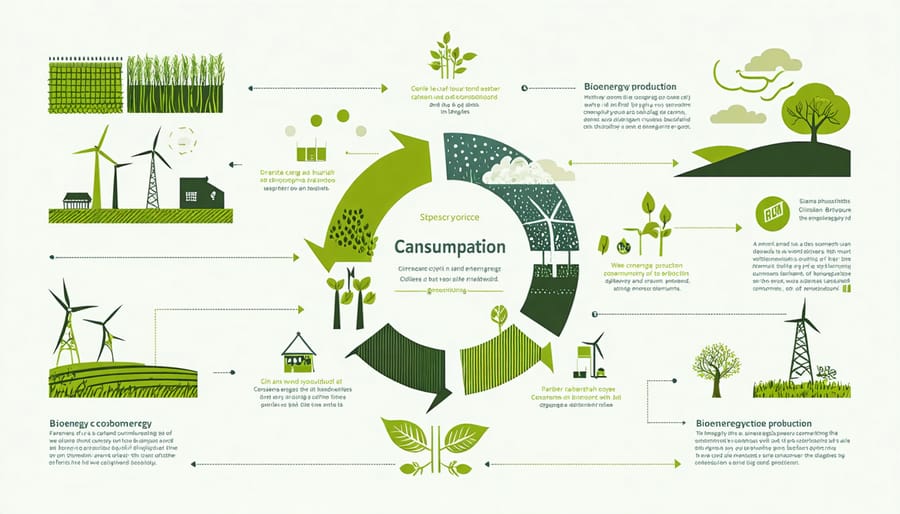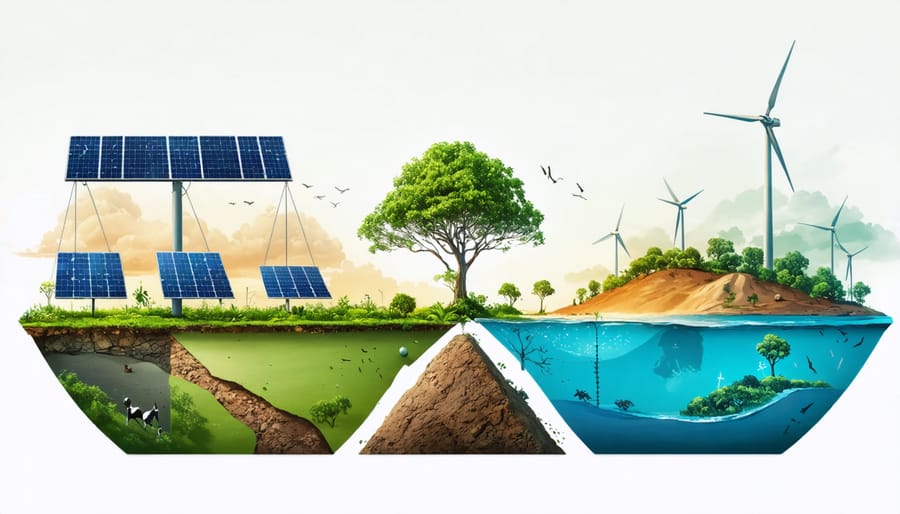In the delicate balance between human activity and Earth’s natural systems, understanding our ecological footprint and biocapacity has become more crucial than ever. Australia’s vast landscapes and unique ecosystems offer both opportunities and responsibilities in managing our environmental impact, particularly as we explore bioenergy’s impact on ecosystems. Like a bank account where we must carefully balance deposits and withdrawals, our planet’s resources require thoughtful management to ensure long-term sustainability.
The concept of ecological footprint measures humanity’s demands on nature, calculating how much biologically productive area is needed to provide the resources we use and absorb our waste. Meanwhile, biocapacity represents nature’s ability to regenerate these resources and absorb waste – essentially, Earth’s ecological budget. As Australia transitions toward renewable energy solutions and sustainable practices, understanding these metrics becomes essential for making informed decisions about resource management and energy production.
This critical relationship between consumption and natural regeneration shapes our approach to environmental stewardship, influencing everything from individual lifestyle choices to national energy policies. By examining these concepts through an Australian lens, we can better understand how to maintain the delicate equilibrium between progress and preservation, ensuring a sustainable future for generations to come.
Understanding Australia’s Ecological Balance Sheet
Measuring Our Environmental Impact
Measuring our ecological footprint involves tracking how much of Earth’s resources we consume compared to nature’s capacity to regenerate them. In Australia, we use a comprehensive calculation method that considers six key factors: cropland, grazing land, fishing grounds, forest products, built-up land, and carbon emissions.
Currently, the average Australian’s ecological footprint is approximately 6.9 global hectares per person – one of the highest rates globally. This means if everyone lived like Australians, we’d need about 4.1 Earths to sustain our lifestyle. The good news is that Australia also has significant biocapacity, thanks to our vast land area and relatively small population.
Our national ecological accounting looks at both consumption and production patterns. We measure resource use through import-export data, domestic production figures, and waste generation statistics. Satellite imagery helps track land use changes, while sophisticated carbon accounting systems monitor our emissions impact.
Leading organisations across Australia are already using these measurements to drive positive change. For instance, several councils now incorporate ecological footprint assessments in their urban planning, while businesses are adopting sustainable practices based on their footprint calculations. These initiatives demonstrate how measuring our environmental impact can lead to meaningful action and sustainable solutions.

Australia’s Natural Capital: Our Biocapacity Advantage
Australia stands as a global powerhouse when it comes to natural capital, boasting one of the highest biocapacities per capita worldwide. Our vast landmass, diverse ecosystems, and relatively small population create a unique advantage in managing ecological resources sustainably.
From the expansive grasslands of the outback to the rich agricultural zones of the Murray-Darling Basin, Australia’s landscape offers tremendous capacity for carbon sequestration and renewable resource generation. Our country’s biocapacity includes extensive forests that act as carbon sinks, productive agricultural lands that support food security, and diverse marine ecosystems that contribute to environmental resilience.
This natural wealth positions Australia advantageously in the global transition toward sustainability. Our solar resources are among the best globally, while our wind corridors and extensive coastline provide additional renewable energy potential. The country’s agricultural sector demonstrates remarkable efficiency, producing enough food to feed 60 million people, far exceeding our population needs.
However, this advantage comes with responsibility. Strategic management of our biocapacity assets is crucial for maintaining their long-term value. By investing in sustainable practices and innovative land management techniques, Australia can leverage its natural capital to lead global sustainability efforts while ensuring economic prosperity for future generations.
Bioenergy’s Role in Reducing Australia’s Carbon Footprint
From Farm to Fuel: Agricultural Biomass Potential
Australia’s agricultural sector presents an extraordinary opportunity for sustainable energy production through its vast biomass energy potential. From sugar cane residue in Queensland to wheat stubble in Western Australia, our farming communities are sitting on a goldmine of renewable energy resources.
Agricultural waste, traditionally seen as a disposal challenge, is now emerging as a valuable energy source. Crop residues, animal waste, and food processing byproducts can be transformed into clean, renewable energy through various conversion technologies. This shift not only reduces waste management costs for farmers but also creates new revenue streams while contributing to Australia’s renewable energy targets.
Consider the sugar industry in Queensland, where bagasse (sugar cane residue) already powers mills and feeds excess electricity back to the grid. Similar success stories are emerging across the country, with grain producers converting wheat straw into pellets for bioenergy production.
The beauty of agricultural biomass lies in its dual benefit: it helps reduce our ecological footprint while supporting our biocapacity. By utilizing existing waste streams, we’re not only preventing greenhouse gas emissions from decomposing organic matter but also reducing reliance on fossil fuels. This circular approach to energy production exemplifies how smart resource management can create win-win situations for both farmers and the environment.

Carbon Cycle Benefits of Bioenergy Systems
Bioenergy systems play a crucial role in reducing our carbon footprint while maintaining ecological balance. When implemented sustainably, agricultural bioenergy production creates a virtuous cycle where carbon emissions are effectively offset through natural processes.
Unlike fossil fuels, which release long-stored carbon into the atmosphere, bioenergy operates within a shorter carbon cycle. Plants used for bioenergy absorb CO2 during growth, which is later released during energy production, creating a near-neutral carbon balance. In Australia, this cycle is particularly effective due to our abundant sunshine and vast agricultural lands.
The benefits extend beyond carbon neutrality. Bioenergy systems help reduce methane emissions from organic waste that would otherwise decompose in landfills. For instance, Queensland’s sugar mills have successfully transformed their waste into clean energy, preventing thousands of tonnes of CO2 emissions annually while powering local communities.
Modern bioenergy facilities are increasingly efficient, with some achieving negative emissions through carbon capture technologies. When combined with sustainable farming practices, these systems can actually sequester more carbon than they emit, creating carbon sinks that benefit our environment for generations to come.
By incorporating native species and smart land management, Australian bioenergy projects are showing how we can boost energy production while enhancing biodiversity and improving soil health. This holistic approach demonstrates that bioenergy isn’t just about reducing emissions – it’s about creating a more sustainable future for all.

Real-World Success Stories in Australian Bioenergy
Australia’s bioenergy sector boasts several inspiring success stories that demonstrate the practical benefits of sustainable energy solutions. The Mount Piper Power Station in New South Wales stands as a shining example, where timber waste from local sawmills is now co-fired with coal, reducing carbon emissions by approximately 60,000 tonnes annually while supporting regional jobs.
In Queensland, the Mackay Renewable Biocommodities Pilot Plant has transformed sugarcane waste into sustainable aviation fuel, creating a circular economy model that’s caught global attention. This initiative not only reduces waste but also provides additional income streams for local farmers.
The Richgro Bioenergy Plant in Western Australia showcases innovation in the commercial sector. By converting organic waste from supermarkets and food manufacturers into energy, the facility generates enough power to run its operations and feeds excess electricity back into the grid, while producing high-quality compost as a by-product.
Victoria’s Yarra Valley Water’s waste-to-energy facility in Melbourne demonstrates the potential of municipal waste management. The facility processes 100 tonnes of food waste daily, generating enough renewable energy to power both the treatment plant and thousands of local homes.
These success stories highlight how bioenergy projects can simultaneously address waste management challenges, reduce ecological footprints, and create economic opportunities while contributing to Australia’s renewable energy targets. They serve as practical blueprints for future initiatives across the country.
Balancing Act: Optimizing Bioenergy Production Within Ecological Limits
Smart Resource Management for Maximum Benefit
Maximising resource efficiency in bioenergy production requires a smart, integrated approach that balances environmental impact with energy output. Australian farmers and energy producers are leading the way with innovative strategies that demonstrate how careful resource management can boost both sustainability and productivity.
One standout approach is the implementation of circular systems, where agricultural waste becomes valuable input for bioenergy production. For instance, sugar cane farmers in Queensland have mastered the art of using bagasse (crushed sugar cane residue) to power their mills while returning nutrient-rich ash to their fields as fertiliser.
Water conservation plays a crucial role in sustainable bioenergy production. Many facilities now employ advanced water recycling systems, reducing freshwater consumption by up to 60%. Smart irrigation techniques, including soil moisture sensors and weather monitoring systems, ensure crops receive exactly what they need, when they need it.
Land use optimisation is another key strategy. Multi-purpose farming, where bioenergy crops are integrated with existing agricultural systems, maximises land productivity while maintaining biodiversity. The growing practice of agroforestry in Western Australia showcases how timber, food crops, and bioenergy feedstock can coexist harmoniously.
Energy producers are also embracing digital technologies to monitor and optimise resource use. Smart meters, IoT sensors, and artificial intelligence help track resource consumption in real-time, enabling quick adjustments to maximise efficiency and minimise waste. This tech-savvy approach ensures that every resource input delivers maximum benefit while maintaining ecological balance.
Protecting Biodiversity While Growing Bioenergy
The expansion of bioenergy production presents both opportunities and challenges for Australia’s ecosystems. Successfully protecting native biodiversity while developing bioenergy resources requires careful planning and implementation of best practices.
Key strategies include establishing buffer zones around critical habitats, selecting appropriate locations for biomass cultivation, and implementing sustainable harvesting techniques. For instance, the successful integration of mallee eucalyptus plantations in Western Australia demonstrates how strategic placement can create wildlife corridors while producing bioenergy feedstock.
Responsible bioenergy development should prioritise using marginal or degraded lands rather than clearing pristine areas. This approach has shown promising results in Queensland, where abandoned sugarcane fields have been repurposed for bioenergy crops, providing new habitat opportunities for local wildlife.
Monitoring and adaptive management are essential components of sustainable bioenergy expansion. Regular biodiversity assessments help ensure that production methods maintain or enhance local ecosystems. The growing network of certified sustainable biomass producers across Australia shows that balancing energy production with conservation is achievable.
By incorporating indigenous knowledge and working with local conservation groups, bioenergy projects can contribute to both renewable energy goals and biodiversity protection. This collaborative approach has already created successful outcomes in several regional initiatives, proving that environmental stewardship and energy production can go hand in hand.
Future-Proofing Australia’s Bioenergy Sector
Australia’s bioenergy sector stands at a crucial turning point, with immense potential to lead the nation’s renewable energy transformation. To ensure long-term sustainability and growth, several key strategies must be implemented across industry and policy levels.
First, investing in research and development of advanced biomass processing technologies is essential. This includes exploring innovative feedstock options unique to Australia’s landscape, such as native grass species and agricultural waste streams that don’t compete with food production.
Creating robust supply chain networks is paramount for industry stability. By establishing regional biomass hubs and fostering partnerships between farmers, processors, and end-users, we can ensure consistent feedstock availability while supporting rural communities.
Education and skills development play a vital role in future-proofing the sector. Technical training programs and university partnerships can create a skilled workforce ready to drive innovation and maintain cutting-edge facilities.
Government support through clear policy frameworks and incentives will encourage private investment and market growth. This includes streamlined approval processes for new facilities and funding support for pilot projects demonstrating emerging technologies.
Industry collaboration is key to sharing best practices and driving efficiency improvements. The formation of industry clusters and knowledge-sharing networks can accelerate adoption of sustainable practices across the sector.
By implementing these strategies, Australia can build a resilient bioenergy sector that contributes significantly to our renewable energy targets while maintaining ecological balance and creating sustainable economic opportunities.
As we’ve explored throughout this article, the relationship between ecological footprint and biocapacity plays a crucial role in shaping Australia’s sustainable future. The growing adoption of bioenergy presents a promising pathway to reduce our ecological footprint while maximizing our nation’s natural biocapacity.
The success stories we’ve examined from across Australia demonstrate that sustainable bioenergy solutions are not just theoretical possibilities but practical realities. From agricultural waste conversion in regional communities to urban biogas facilities, these initiatives show how we can effectively balance human needs with environmental preservation.
However, achieving a sustainable balance requires collective action. Businesses, communities, and individuals all have essential roles to play. By embracing renewable energy solutions, implementing efficient resource management practices, and supporting local bioenergy initiatives, we can work together to reduce our ecological footprint.
The time for action is now. Australia’s abundant natural resources and innovative spirit position us perfectly to become a leader in sustainable bioenergy adoption. Through careful planning, strategic investment, and community engagement, we can create a future where our ecological footprint remains within our biocapacity limits.
Let’s commit to making conscious choices that support sustainable practices, advocate for renewable energy policies, and actively participate in the transition to cleaner energy solutions. Together, we can build a more sustainable and prosperous Australia for generations to come.

